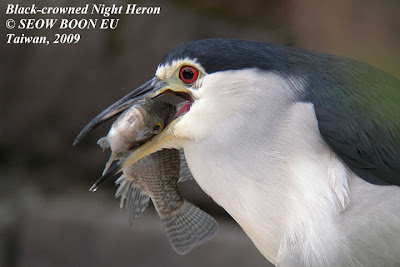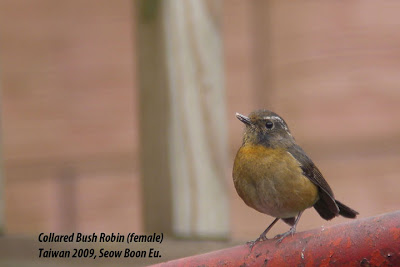When I mentioned, "I went to Taiwan".
The questions I received were usually "did you see any celebrity, pop singer?", "did you visit Taipei101", "did you see any pretty Alishan girl?", influenced by the Taiwanese folk song : <.. Alishan's girls.. as pretty as the water..>, "did you visit sun-moon lake? or Penghu?", "took any Taiwan pictures?" et cetera.
My usual answer to above questions was simple: "No, I went to Taiwan for bird watching, and I have only bird pictures", and the replies were: "what! watching birds?", "you visited bird park? zoo?". The best reply I received was "great, you must have seen a lot of lifers"
Taiwan is an island nation located at the west Pacific Ocean and off the southeastern edge of the Asian mainland. It has the highest peak in East Asia, the Yushan Mountain. It straddles the Tropic of Cancer with a tropical south and sub-tropical north.
Due to the suitable geographical condition and isolation, Taiwan is one of the countries in the world with a high rate of endeminism of avifuana. Taiwan is also located at the East Asian-Australasian bird migration flyway, therefore many migratory birds from the North Asia and Siberia visit Taiwan during the autumn and winter months.
I spend 18 days in Taiwan (9-26 Nov.), and mainly traveled in the northern part of the islands. At the beginning, I followed the five days bird tour guided by the Taipei Wild Bird Society, places visited include Taipei city, Yilan, Taroko, Hehuanshan, Puli, Tashyueshan, Hsinchu, Wulai.
After the bird tour, I stayed in Taipei for couple of days to attend the microelectronics conference. After the conference, I visited Yangmingshan, Guandu nature park, parks and gardens in the Taipei city. Later, I proceeded to Alishan and Tataka with the hope of spotting the Mikado Pheasant or Swinhoe's Pheasant.
Unfortunately, I didn't spot the Mikado Pheasant or Swinhoe's Pheasant, but a replica of Mikado Pheasant at the visitor center of Tataka National Park, as a consolation token for the "never give up" spirit (haha..). I then ended my Taiwan birding trip in Taipei city and county on the last three days.
In this birding trip, I saw 12 endemic species and all were lifers. Most birds in Taiwan are easy to see and photograph. Strangely, I didn't see any photographer in Taiwan using flash for photographing the wild birds, but it is very common practice in Malaysia and Singapore.
The digiscoped bird photos of my Taiwan trip are shown in the list as follows:
Taiwan endemic species: According to Taipei Wild Bird Society, Taiwan has 17 endemic species, and I spotted 12 and digiscoped 9 of them. They are Taiwan Bulbul, Taiwan Whistling Thrush, Taiwan Laughingthrush, Collarred Bush-robin, Steere's Liocichla, Taiwan Barwing, Flamecrest, Taiwan Blue Magpie, Taiwan Barbet, Yellow Tit (no picture), Taiwan Sibia (no picture), Taiwan Yuhina (no picture).
I missed the Mikado Pheasant, Swinhoe's Pheasant, Taiwan Hill Patridge, Taiwan Hwamei and Taiwan Bush Warbler. I wonder where are these birds? are they blown away by the fearsome Morokot typhoon?.
Check out this LINK to view more pictures of Taiwan endemic species.
Taiwan endemic subspecies: I spotted more than 20 endemic subspecies. They are Slaty-breasted Rail, Crested Goshawk, Crested Serpent Eagle, Eastern Turtle Dove, Spotted-necked Dove, Japanese Green Pigeon, Chinese Bulbul (including hybrid Taiwan/Chinese Bulbul), Grey-cheeked Fulvelta, Rufous-capped Babbler, Streak-breasted Scimitar Babbler, Black Bulbul, Winter Wren, White-browed Bush Robin, Plumbeous Water Redstart, Coal Tit, Green-backed Tit, Varied Tit, Vinaceous Rosefinch, Black Drongo, Bronzed Drongo, Grey Tree Pie, Spotted Nutcracker, Long-tailed Shrike, and Fire-breasted Flowerpecker.
Check out this LINK to view more pictures of Taiwan endemic subspecies.
Malayan Night Heron: This bird is easy to see in Taiwan, it can easily be found in the gardens or parks in Taipei city. I have seen this bird in Buddhist temple in Puli, Taipei Botanic Gardens, Da'an Park in Taipei, Chiang Kai Shek Memorial Park and Public Park in Yangmingshan. It is a non-endemic lifer for me.
 Check out this LINK to view more pictures of Taiwan's Malayan Night Heron.
Check out this LINK to view more pictures of Taiwan's Malayan Night Heron.
Non-endemic Lifers :
Besides the endemic species and subspecies, there are also some non-endemic bird lifers that I saw in Taiwan. The non-endemic lifers I spotted included Black-faced Spoonbill, Oriental Iblis, Spot-billed Duck, Nortern Shoveler, Northern Pintail, Tufted Duck, Common Teal, Common Coot, Fork-tailed Swift, Japanese White-eye, Eurasian Nuthatch, Daurian Redstart, Blue and White Flycatcher, Yellow Wagtail, Brown Dipper, Dusky Thrush, Bambling, and Black-collared Starling.
The most memorable non-endemic lifer that I saw was the Black-faced Spoonbill, I saw it in Yilan, Taiwan.
Check out here to view my non-endemic lifers in Taiwan. coming soon
Water Birds in Taiwan
Water sources and wetlands are important areas for most of the waterbirds in Taiwan, you can find many resident and migratory water bird species in these areas. One of my best digiscoped water bird picture is shown as follows:
Guide to Birding in Taiwan:
I strongly recommend and encourage one to carry an illustrated field book, because I do not know how the author took the bird photographs in most of the photographic bird books. Visit this LINK to read the review about Taiwan's field guide and birding guide books by Birdingnerd.
Personally, I would recommend Field Guide to the Wild Birds of Taiwan (台灣野鳥圖鑑) by Wu Sen-hsiang et al and illustrated by Takashi Taniguchi (谷口高司). It is jointly published by the Taiwan Wild Bird Society and the Wild Bird Society of Japan, written mainly in Traditional Chinese with English species common name, but some of the English bird names are not updated.
For the updated English species common name, MacKinnon and Phillip’s Field Guide to the Birds of China is recommended, and this book is very useful if you visit China for birding. I bought the simplified Chinese edition, which is much cheaper and light compared to the English edition.
Another recommended guide book is Birds of East Asia by Mark Brazil, this book covers Taiwan, Japan, Korean, East and North East China, and Far-east Russia, it is thick and expensive, not easy to carry to the field but is good as a reference. Probably the most updated book on Taiwan endemic species.
Birdwatching in Taiwan by Rui-De Shi is a must have book if you are going there without any guide. You can purchase all these books from the Taipei Wild Bird Society, you can also contact them for more information about birding in Taiwan.
Taiwan is a tourist friendly nation, you can get most of the information online or at the Taoyuan airport, MRT or their high-speed train station. Mandarin, Hokkien and Hakka are widely used in Taiwan, English and Japanese are also spoken in the cities and tourist areas.
Taiwan, one of the countries in the world with a high rate of endeminism of avifuana, a highly recommended birding place in Asia.
** This blog is specially dedicated to Meng Meng, and pray that he will get well soon.
 Let's take a look of the bird, especially that fascinating pheasant tail, but where is the pheasant tail?.
Let's take a look of the bird, especially that fascinating pheasant tail, but where is the pheasant tail?. Actually, this visiting Jacana is a non-breeding adult. The long blackish pheasant tail is only appeared in the breeding adult, and can only be seen in Indo-china, South-west China, Taiwan and India. One of the best place to see this breeding adult plumage is in Guantian Jacana Conservation Area in Tainan county, Taiwan.
Actually, this visiting Jacana is a non-breeding adult. The long blackish pheasant tail is only appeared in the breeding adult, and can only be seen in Indo-china, South-west China, Taiwan and India. One of the best place to see this breeding adult plumage is in Guantian Jacana Conservation Area in Tainan county, Taiwan. visit this LINK to learn more about Jacana (in Chinese only), or visit this LINK to find out more about Pheasant-tailed Jacana in Taiwan
visit this LINK to learn more about Jacana (in Chinese only), or visit this LINK to find out more about Pheasant-tailed Jacana in Taiwan


 Here are what I saw in Air Hitam Dalam. My old avian friend Mangrove Blue Flycatcher:
Here are what I saw in Air Hitam Dalam. My old avian friend Mangrove Blue Flycatcher: 
























































